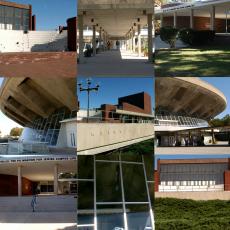Lasting support: Alumnus leaves lasting architectural legacy

Online Poster
September 22, 2004
Max Abramovitz, architecture alumnus, left behind more than a few campus buildings when he died Sept. 12. He left behind a legacy.
Abramovitz designed Assembly Hall, Krannert Center for the Performing Arts and the Hillel Foundation for Jewish Campus Life. His firm also designed part of the Lincoln Center for the Performing Arts and other buildings in New York. In addition to his long-standing architectural presence, Abramovitz also leaves his financial support to the School of Architecture with the Abramovitz endowment.
“This fund supports lecturers and speakers coming to spend time at the school of architecture,” said Kurt Baumgartner, architecture professor.
Many students know of Abramovitz through an Assembly Hall myth. Some say Abramovitz received a “C” on the plans he turned in for Assembly Hall and his professor told him it was a good idea, but would never work in reality. Baumgartner said this event never occurred.
Assembly Hall broke new architectural ground when it opened in 1963. It was one of the first edge-supported domes in the world.
Get The Daily Illini in your inbox!
Over the years, Assembly Hall has hosted different entertainers ranging from Elvis Presley to Dave Chappelle.
Krannert Center for the Performing Arts also hosts many different performing groups throughout the year.
In addition to performances within the school of music and the school of dance, Krannert attracts many outside acts to the University.
“There are 45 or more performances by guest artists each year. These range from the Chicago Symphony Orchestra to different solo artists,” said Tammey Kikta, Krannert Center public information director.
Performers and audience members are able to experience Krannert’s high acoustic quality in the different theaters.
“It is a difficult thing to have a single theater that can accommodate a vast array of different performances … (Abramovitz) solved that problem by having different theaters with different acoustic properties and capabilities for the different art performances,” Baumgartner said.
The Hillel Foundation for Jewish Campus Life on John Street was also one of Abramovitz’s works. It was built in 1950 and serves the University Jewish community. The University’s Hillel Foundation is the first of its kind. The 2004-2005 school year marks its 81st year in operation.
“The Center has a wide range of programs for students on campus from religious programs to meal plans and social opportunities,” said Rabbi Yitzchak Falk.
The University of Illinois campus is not the only campus on which Abramovitz left his mark. He also served as the campus architect for Brandeis University in Massachusetts and designed its Three Chapels.
Baumgartner said Abramovitz’s contact with the University went beyond his architectural contribution.
“He has been a friend to a number of the faculty and stayed in touch with them over the course of their lives … He has been very close to the school.”






